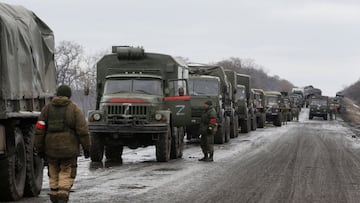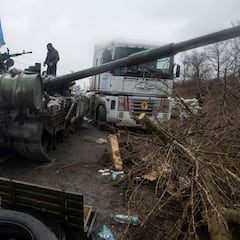Why is the 64-kilometre Russian convoy not moving towards Kyiv?
A convoy of Russian forces approaching Kyiv from the northwest has stalled en route to the Ukrainian capital, here’s a look at the problems its facing.

A column of Russian forces stretching 64 kilometers, or about 40 miles, including armored vehicles, artillery and tanks, has been moving at a snail’s pace toward Kyiv. The vanguard of the massive assembled military might has halted its advance 25 kilometers (15 miles) outside of the Ukrainian capital.
Military analysts are baffled by the slow advance of the Russian military since it started its invasion 24 February. Several reasons could explain why including logistical and mechanical problems, as well as low morale among Russian troops, especially in the face of unexpected Ukrainian resistance.
Also see:
- Photo of Ukrainian girl with a lollipop and a rifle goes viral
- Russian's strategy behind capturing Ukrainian nuclear assets
- Russia lays out demands for end to the Ukraine war
- How long can Russia fight a war in Ukraine?
- Anonymous hack Russian TV
Russian convoy caught in 40-mile-long traffic jam
Images of the huge column of military hardware show that at times vehicles are three abreast on the road leading to Kyiv, completely blocking the flow in either direction. This has knock-on consequences impeding supply transports from carry material and fuel to the front or even returning to pick up more.
The pile-up on the road is due to the inability of the Russians to travel across muddy terrain that appears not to have frozen solid due to the mild winter this year. Across social media there are images of heavy tracked vehicles that Russian soldiers abandoned after getting trapped in the mud.
NEW: Russia's 40-mile long convoy of tanks, artillery and supplies that has stalled miles from Kyiv after Ukrainian strikes, depicted in a 3D rendering.
— Jack Detsch (@JackDetsch) March 4, 2022
Pentagon spokes John Kirby told MSNBC today that Ukrainians hit the convoy's lead vehicles, forcing it to halt.
📹:@Maxar pic.twitter.com/MvKZMh20Qq
Russian forces have maintenance issues keeping them on the roads
A lack of maintenance is also hindering the movement of wheeled vehicles according to analysis by Trent Telenko, a retired Department of Defense civil servant who worked as an auditor for America’s Defense Contract Management Agency. Looking at photos of captured Russian hardware with damaged wheels he says they were not periodically moved to avoid sunlight rotting the tire walls and exercise the inflation system to keep them supple.
He attributes this failure to endemic corruption that would affect all the forces fighting vehicles and supply trucks. The problem will be more notable in the northern Ukraine and be exacerbated as the infamous Rasputitsa, or thaw, takes hold in more areas. This will force the Russians to stay on the roads where they are vulnerable to attacks by Ukrainian forces creating roadblocks with damaged vehicles.
This is a thread that will explain the implied poor Russian Army truck maintenance practices based on this photo of a Pantsir-S1 wheeled gun-missile system's right rear pair of tires below & the operational implications during the Ukrainian mud season.🧵
— Trent Telenko (@TrentTelenko) March 2, 2022
1/ pic.twitter.com/LmxW43v6gy
Logistics problems limiting resupply of food and fuel
The Russians have already seen equipment rendered useless just from lack of gas. An analysis of a RAND study looking at a hypothetical invasion of the Baltic states estimated the Russian army would have to refuel at least once for an operation that lasts 36 to 72 hours. The Russians began their push toward Kyiv from Belarus 24 February.
Related stories
The fact that their material is blocking all the available pavement space is hindering resupply. It is also the probable cause of high-level Russian officials being killed by Ukrainian snipers. On 3 March, Major General Andrei Sukhovetsky, deputy commander of the Combined Arms Army of the Central Military District, was killed when he ventured to the front of the stalled 40-mile-long military convoy northwest of Kyiv. He had been the highest-ranking Russian official killed so far in the invasion of Ukraine.
There have also been reports of Russian soldiers lacking food further affecting low morale as they are harried by a far stronger resistance from Ukrainian forces and civilians that have taken up arms. Ukrainian forces have attacked different sections along the length of the convoy creating additional obstacles and leaving it vulnerable to even more as it sits idle.


